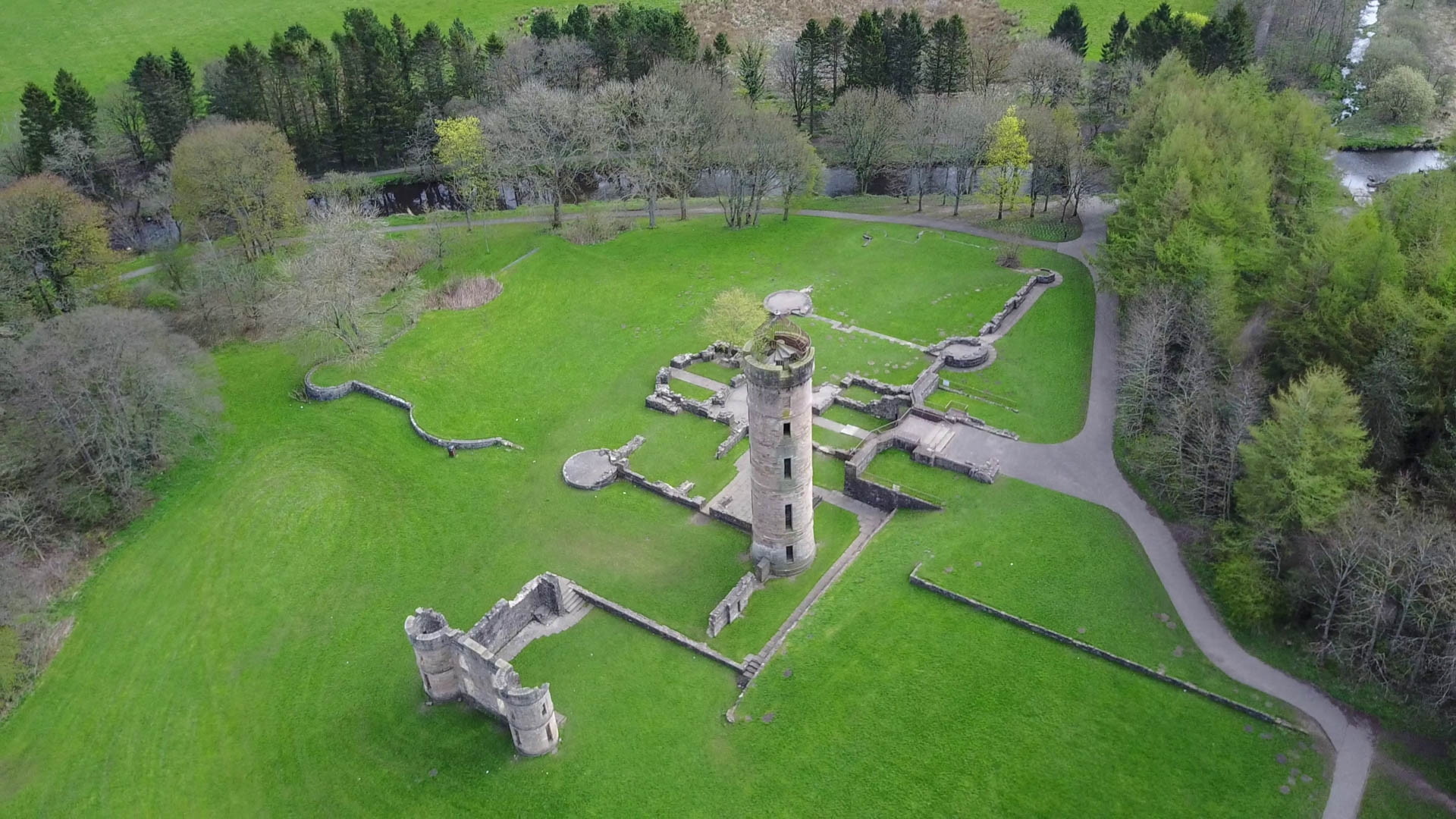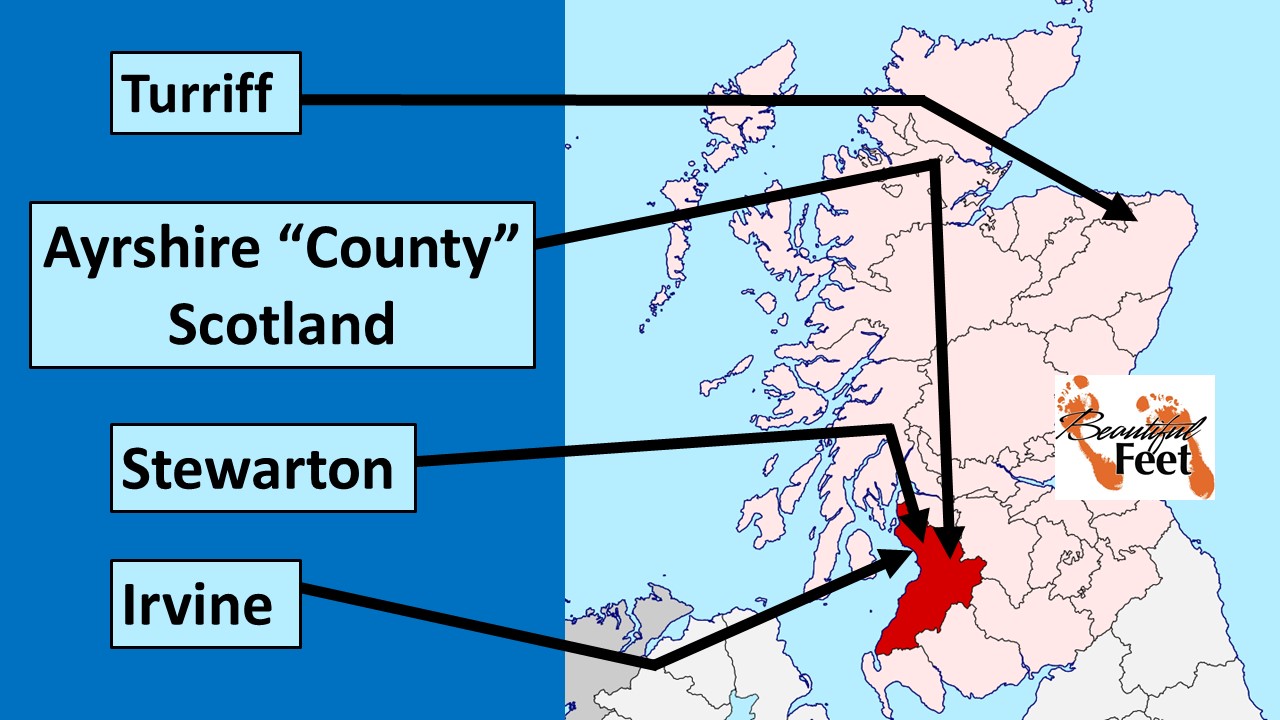
 The revival spread throughout the county of Ayrshire, on the southwest side of Scotland.
The revival spread throughout the county of Ayrshire, on the southwest side of Scotland.
Introduction
The name of this revival was taken from the town of Stewarton, although documentation clearly shows that it began in and spread out from Irvine. There is no information available that explains why the name of Stewarton rose to the forefront. Though it is an assumption, one possible explanation could be that the revival grew stronger in Stewarton and had more of an impact there, as the revival did spread powerfully throughout the county of Ayrshire.

Eglinton Castle Ruins: at times used to house and protect persecuted ministers
Background Information
► During the 1500s and 1600s, Scotland’s spiritual condition varied between the larger towns—which had established churches and ministries and an orderly society—and the villages and rural countryside which were still primitive. These primitive areas had rampant witchcraft and sorcery, along with lawlessness.
► “Readers” were sent into the rural areas to read portions of Scriptures, as well as to read prayers, but there were no established ministries in those areas at this time.
► Serious religious persecution was experienced at the whim of monarchs, magistrates, and the clergy. Persecution was first conducted at the hands of Roman Catholics toward Protestants (English Reformation), then among the Protestants themselves (Martyrs; Covenanters; Scots Confession; Five Articles of Perth).
It was in this environment that this revival occurred.
Main Characters in the Story
1. David Dickson was the minister of the Presbyterian Church of Scotland in the town of Irvine. It was Dickson who became the spark for the revival which spread from Irvine to Stewarton, and throughout Ayrshire.
Dickson became the minister at the Irvine church in 1618. On January 9, 1622, he was summoned to appear before the court at Edinburgh to answer to charges on his refusal to comply with the Perth Articles. His refusal to yield to the authorities compliance with that statute led the authorities to remove him from his position in Irvine and he was then banished to Turriff, in north Scotland. At the end of June 1623, Dickson petitioned the Earl of Eglinton for his release from banishment, and his sentence was overruled and he returned to Irvine to his pastorate. Upon Dickson’s return he began to see many souls come to Christ, and it was not only those from Irvine. People from neighboring towns were coming to hear his sermons, and some even moved from distant parts of the country to live in Irvine to be part of his ministry.
2. Mr. Castlelaw (no first name given) at this time was the minister of the Presbyterian Church of Scotland in Stewarton.
3. Robert Blair frequently preached during the revival and spent time giving counsel to the many new Christians converted during the revival.
What Happened
Dickson’s preaching became so powerful at Irvine that many came under severe conviction of sin. They were so overpowered by the awareness of the Holy Spirit’s presence that they had to be carried out of the church.
After the Sunday evening sermons, those who were under conviction of sin—often times over 100 of them—would meet at the large hall in Dickson’s home (manse) where he would spend several hours with them, giving spiritual counsel.
As David Dickson’s popularity increased he took advantage of the open door the Lord granted him and began preaching on market day in Irvine (Mondays). This was the day when the crowds were the largest, and he gave his sermons prior to the opening of the market so all could participate without being interrupted with their business.
The people from the area of Stewarton, having heard of the revival that had commenced in Irvine, began attending Dickson’s weekly marketplace sermons, with their minister, Mr. Castlelaw, encouraging them to attend.

Hindrances to the Revival
It is always ministers, from within the Church, that are the largest hindrances to revival, and with this revival it was no different (Revival Principle #8). There were those who were opposed to preaching in public, outside of a church building, as well as the deep workings of the Holy Spirit which brought intense conviction of sin. This opposition led to the revival being called the “Stewarton Sickness.”
Every revival will be attacked by Satan to bring reproach on the entire work. Satan’s methods are:
1. Influencing Christians to draw attention to themselves through unbridled release of their emotions.
2. Using non-Christians or Christians to produce false prophecies, teachings, or miracles to distract from what is true.
During the Stewarton Revival this took place, but Dickson and others took cautious and direct action, addressing the situation, and the revival then grew even more powerful.
 Map shows the locations of towns and areas mentioned in this story.
Map shows the locations of towns and areas mentioned in this story.
Results of the Revival
► Dramatic life transformations regularly occurred.
► People coming from distant parts of the country were greatly inspired to commit themselves to more earnest prayer for the outpouring of the Holy Spirit on the Church throughout the nation.
► The revival had the favor of being promoted by Anna, Countess of Eglinton and other esteemed individuals of that time.
► It was by means of these Monday and other weekday sermons that the famous Stewarton Revival began to spread from house to house (Revival Principle #5).
► This revival continued from 1625 till about 1630, as it continued to spread the many miles throughout the county of Ayrshire.
Sources
► David Dickson by Wikipedia
► Foxe’s Book of Martyrs by John Foxe
► Narratives of Revivals of Religion in Scotland, Ireland, and Wales by anonymous
► Robert Blair by Wikipedia
► The Revivals at Stewarton and Kirk of Shotts by Thomas M’Crie
Return to List of Revival Stories
Chet & Phyllis Swearingen
(260) 920-8248
romans1015@outlook.com
Beautiful Feet
P.O. Box 915
Auburn, IN 46706

